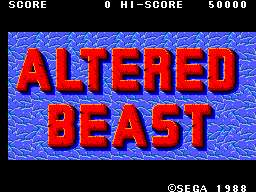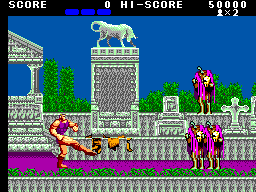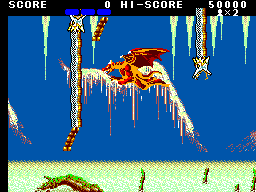|
 |
|
|
|
|
Review Information |
|
|
 |
|
|
Reviewer Name: |
Anthony Burns |
|
|
|
|
|
|
Game Difficulty: |
Medium |
|
|
Difficulty Options: |
True |
|
 |
|
|
|
 |
|
|
|
|
Game Information |
|
|
 |
|
|
Full Title: |
Altered Beast |
|
|
Year Released: |
1989 |
|
|
Game Type: |
Fighting |
|
|
Max Players: |
1 |
|
 |
|
|
|
| Introduction |
|
|
| Strange I should find myself motivated to defend this particular title, as it isn't exactly a classic on any format, the arcade game itself being a notoriously shallow scrolling brawler in the "Kung Fu Master" variety (albeit with rotting corpses and eldritch horrors to pummel rather than endless Chuck Norris clones). That being said, it is one of the rare arcade games of its generation not to spawn a truly awful conversion on any format, even the colour-clashy Spectrum version being reasonably faithful considering the hardware, and the admittedly goofy-looking NES version having the additional value of extra levels. But how does the SMS version measure up? |
| Gameplay |
| Walk, kick, punch, grab power ups, try not to die, occasionally jump (if you can bear to, as the jump control is one of the worst aspects of this game), survive long enough to become the beast and then gleefully pwn every hapless enemy sprite on the battlefield ... until the boss turns up, that is. Pretty basic, but as brainless bashers go, it always had a curious charm, no doubt much to do with ditching the standard arcade scenarios of dirty streets and martial arts dojos for the sheer bizarreness of fist-fighting a zombie apocalypse (and friends) in Ancient Greece.
The Master System version retains most of the enemies and powers of the original, though sadly loses the third level (I would guess because the agility of level 3's werebear - with powered sonic-style jumping in the arcade - was a bit beyond this choppy engine). Like Golden Axe on the SMS, the large and ambitious graphics do cause a certain clunkiness in player movement, which makes reacting to danger very tricky (and surviving massed groups of enemies almost impossible, if you fail to get the attack in first). This can lead to a lot of frustration, though saying that, the game is pretty short and not too difficult once a few of the attack waves are memorised. On the plus side, the boss arenas are larger in this version, offering generous room to manouever: especially in the case of the first boss, who was almost guaranteed to knock off a life or two on some home versions, owing to the small screen space and the size of his projectiles. Each boss fight offers a satisfying conclusion to the level, and the final one is a particularly stiff challenge (though all the more satisfying when he goes up in smoke).
Definitely not the smoothest version, though beats the Spectrum and Amstrad versions in that regard and though it loses out to the C64 version in some aspects (third level especially...) it crucially retains all the powers, the omission of which made the C64 version all but unplayable. It also has a larger screen area than the HUD-dominated home computer versions. Probably the best of the 8-bit versions (though none actually go so far as to disgrace their hardware - the NES probably coming out worst but making up for its deficiencies with the extra levels). |
| Graphics |
| Reminiscent of Golden Axe for the SMS, in that it manages to look in still shots almost like the Amiga version, but in play it looks more like the Spectrum / Amstrad versions, the main character lurching clumsily from char to char to the extent that you just know many poor software sprites are being squeezed for all their worth and then some ... Why this version gets slated for graphics I will never know, as the questionable performance and flicker is testimony to the fact that the SMS is punching way above its weight with these graphics. The enemy death sequences probably don't help much: in lieu of the gruesome dismemberments of the arcade and the sadly pathetic gibs of the Megadrive version, the SMS enemies literally shatter into tiny fragments, which can look quite impressive with whole hordes of zombies or large enemies like the rattlesnake-dragons (whatever it may contribute to the general sense of wading through treacle...).
Still, the close resemblance to the arcade in colour and detail is very praiseworthy, not to mention the preservation of the beast transformation screens (Simplified a bit, but still more than any home computer version managed). The bosses are a little reduced, but still large and impressive, though fought against a blank screen (as was common on the SMS - no doubt the bosses themselves are drawn using background resources rather than sprites, as in Ghouls 'n' Ghosts). A few of the enemies are also reduced in size and poorly defined, especially on the last level, where the full human-sized enemies of the arcade are rather pathetically chibi-fied. Most, however, closely resemble the originals, especially the various zombie types and the impressive snake-dragons. The beast powers, in general, look better on this version than in the 16-bit Genesis version (where the flame arrow effects, in particular, were very crudely drawn). The presentation is a little underwhelming, with a cut-down end sequence and very sparse attract screen, but even so this is easily the best looking 8-bit version (unless the Turbografx counts as 8-bit, but that is hardly a level playing field with the humble SMS). Possibly a bit too ambitious for its own good. |
| Sound & Music |
| A few speech samples, sadly not including "Wise from your gwave..." Still, more than the 8-bit computer versions included, so again the SMS is the leader in its generation. The music is obviously of the lo-fi variety, but still accurately recomposed and atmospheric. Unfortunately, the boss battles are fought in dead silence, which does nothing for the atmosphere (and for some reason, the boss music has become the standard BGM for two of the levels instead). |
| Controls |
| This is the major sticking point. Keying the attack moves to the buttons was understandable, but making it necessary to press both buttons simultaneously to execute a jump (instead of simply pressing up on the pas, perhaps?) is pure and simple sadism. Given the amount of flying enemies in this game, and the amount of time you will have to spend on platforms in the later levels, this will almost certainly prove the biggest source of frustration in an already less-than-silky-smooth gaming experience. I suspect that had this awful control scheme been refined, this game might have taken a lot less stick over the years. Still, at least all the moves are present and correct, so it is still a better route than a C64 alternative (Cutting some moves out completely). |
| Replay Value |
|
| No real variety or enemy AI, so replays offer little in the way of new experience, except for players who wish to make life harder (by deliberately avoiding power ups and extending the levels, which can make the game about three times as long - though still scarcely varied). |
| Conclusion |
| Faithful and ambitious conversion of an unremarkable but weirdly appealing and graphically imaginative coin-up, though let down by control issues. However, an impressive feat of 8-bit programming. My sister, on seeing me playing this version, was surprised to hear it was not the Genesis version, which is a fair testimony to the amount of detail it was able to capture. However, there is no doubt it makes some major gameplay sacrifices to achieve that, so I wouldn't prioritize this over simply playing the original in MAME. Still, in the days before MAME I was more than happy (if frequently frustrated) with this version. |
|
|
|
|













